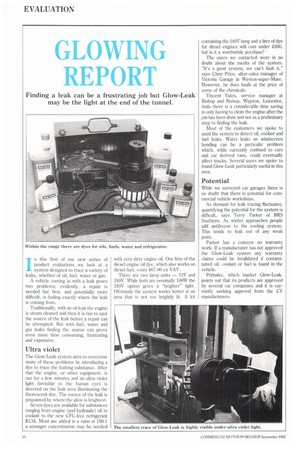GLOWING REPORT
Page 96

If you've noticed an error in this article please click here to report it so we can fix it.
In this first of our new series of product evaluations we look at a system designed to trace a variety of leaks, whether of oil, fuel, water or gas.
A vehicle coming in with a leak poses two problems; evidently, a repair is needed but first, and potentially more difficult, is finding exactly where the leak is coming from.
Traditionally, with an oil leak the engine is steam cleaned and then it is run to spot the source of the leak before a repair can he attempted. But with fuel, water and gas leaks finding the source can prove even more time consuming, frustrating and expensive.
Ultra violet
The Glow-Leak system aims to overcome many of these problems by introducing a dye to trace the leaking substance. After that the engine, or other equipment, is run for a few minutes and an ultra violet light (invisible to the human eye) is directed on the leak area illuminating the fluorescent dye. The source of the leak is pinpointed by where the glow is brightest.
Seven dyes are available for substances ranging from engine (and hydraulic) oil to coolant to the new CFC-free refrigerant R134. Most are added in a ratio of 150:1 a stronger concentration may be needed with very dirty engine oil. One litre of the diesel engine oil dye, which also works on diesel fuel, costs £67.60 ex VAT.
There are two lamp units — 12V and 240V. While both are nominally 100W the 240V option gives a "brighter" light. Obviously the system works better in an area that is not too brightly lit. A kit containing the 240V lamp and a litre of dye for diesel engines will cost under £200, but is it a worthwhile purchase?
The users we contacted were in no doubt about the merits of the system. "It's a good system, we can't fault it," says Chris Price, after-sales manager of Victoria Garage in Weston-super-Mare. However, he does baulk at the price of some of the chemicals.
Vincent Yates, service manager at Bishop and Bishop, Wigston, Leicester, finds there is a considerable time saving in only having to clean the engine after the job has been done and not as a preliminary step to finding the leak.
Most of the customers we spoke to used the system to detect oil, coolant and fuel leaks. Water leaks on windscreen bonding can be a particular problem which, while currently confined to cars and car derived vans, could eventually affect trucks. Several users we spoke to found Glow-Leak particularly useful in this area.
Potential
While we surveyed car garages there is no doubt that there is potential for commercial vehicle workshops.
As demand for leak tracing fluctuates, quantifying the potential for the system is difficult, says Terry Parker of BRS Southern. As winter approaches people add antifreeze to the cooling system. This tends to leak out of any weak point.
Parker has a concern on warranty work. If a manufacturer has not approved the Glow-Leak system any warranty claims could be invalidated if contaminated oil, coolant or fuel is found in the vehicle.
Primalec, which market Glow-Leak, points out that its products are approved by several car companies and it is currently seeking approval from the CV manufacturers.




































































































